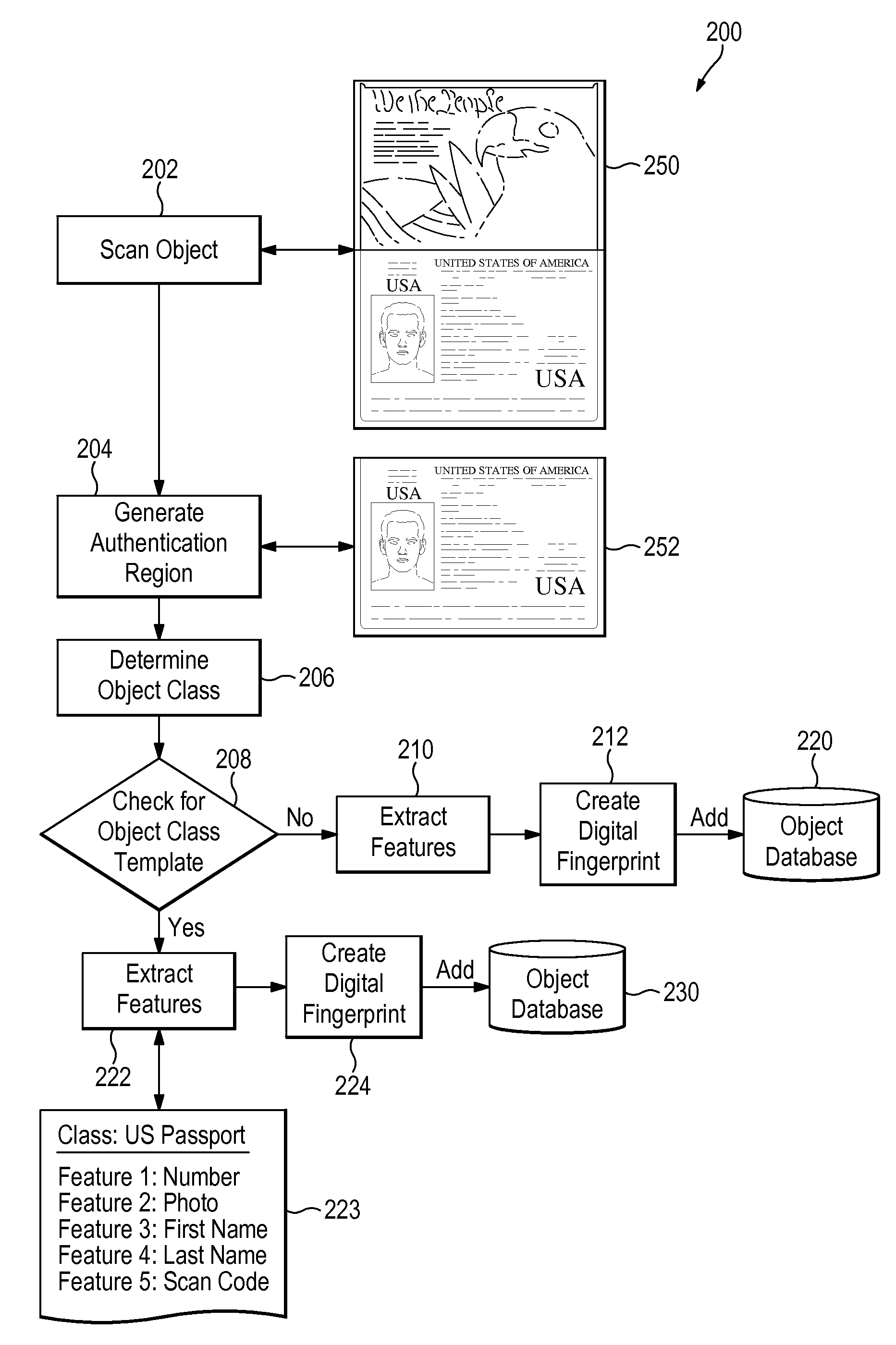Digital fingerprinting object authentication and anti-counterfeiting system
a fingerprinting object and object technology, applied in image watermarking, instruments, image enhancement, etc., can solve the problems of counterfeit computer chips, identification documents, and counterfeit products that pose significant risks to national security, counterfeiting of manufactured goods is a worldwide problem, and counterfeiting of many classes of goods is a global problem
- Summary
- Abstract
- Description
- Claims
- Application Information
AI Technical Summary
Benefits of technology
Problems solved by technology
Method used
Image
Examples
case # 1
[0075]Case #1: For authentication of a previously fingerprinted object, the following steps may be followed (see FIG. 3, discussed below):[0076]1. The authentication region (or regions) are either determined automatically by the system, or by utilizing the authentication region definitions stored in an Object Feature Template.[0077]2. The relevant features are extracted from the authentication region(s) and the digital fingerprint is created. This will typically be in the form of feature vectors, but other data structures may be used as appropriate.[0078]3. Optionally, a unique identifier such as a serial number may be extracted and stored to augment subsequent search and identification functions.[0079]4. The digital fingerprint of the object to be authenticated is compared to the digital fingerprints stored in the database.[0080]5. The system reports whether the object is authentic; i.e. whether it matches one of the digital fingerprints stored in the database.[0081]6. The system m...
case # 2
[0084]Case #2: For inspection of specific features of a previously fingerprinted object to determine whether they have been altered, the steps are similar to Case #1, but the process is used for the detection of alterations rather than authentication of the object:[0085]1. The authentication region (or regions) are either determined automatically by the system, or by utilizing the authentication region definitions stored in an Object Feature Template.[0086]2. The features to be inspected are extracted from the authentication region and the digital fingerprint is created. This will typically be in the form of feature vectors for the features to be inspected but other data structures may be used as appropriate.[0087]3. Optionally, a unique identifier such as a serial number may be extracted and stored to be used to augment subsequent search and identification functions.[0088]4. The digital fingerprint of the features to be inspected for alteration is compared to the fingerprint of the...
case # 3
[0091]Case #3: For inspection of the specific features of an object that has not been previously fingerprinted to determine whether the features have been altered, the following steps may be followed, referring now to FIG. 4.
[0092]The system scans the object, block 404, and creates an authentication image 450 that includes at least one authentication region. The authentication region (or regions) may be determined automatically by the system, or by utilizing the authentication region definitions defined in a stored Object Feature Template 406 as noted earlier. Either way, the process next extracts features from the authentication region(s), block 408, and a digital fingerprint is created. This will typically be in the form of feature vectors, but other data structures may be used as appropriate.
[0093]The features of the object are then analyzed, block 420, and examined for attributes indicative of a counterfeit, block 402. Methods may be applied to the features by running programs t...
PUM
 Login to View More
Login to View More Abstract
Description
Claims
Application Information
 Login to View More
Login to View More - R&D
- Intellectual Property
- Life Sciences
- Materials
- Tech Scout
- Unparalleled Data Quality
- Higher Quality Content
- 60% Fewer Hallucinations
Browse by: Latest US Patents, China's latest patents, Technical Efficacy Thesaurus, Application Domain, Technology Topic, Popular Technical Reports.
© 2025 PatSnap. All rights reserved.Legal|Privacy policy|Modern Slavery Act Transparency Statement|Sitemap|About US| Contact US: help@patsnap.com



